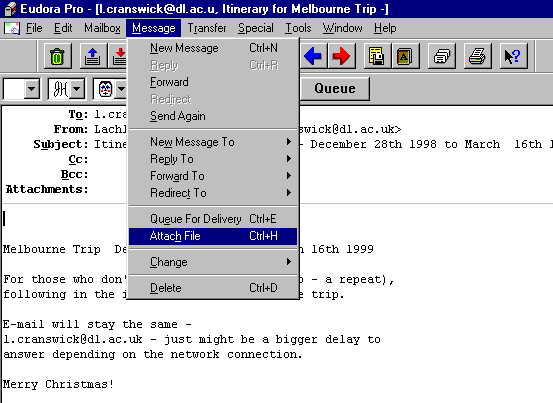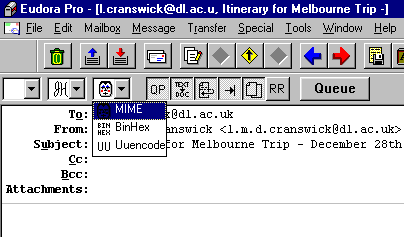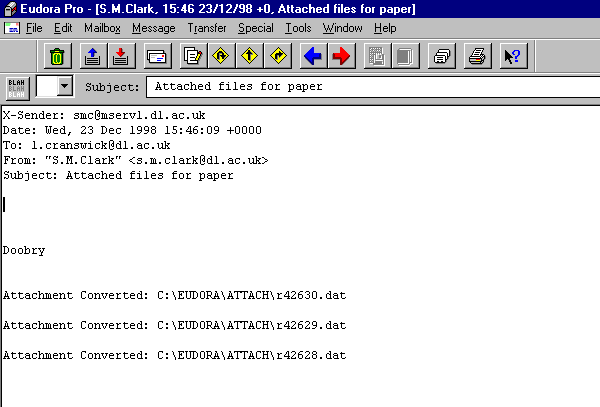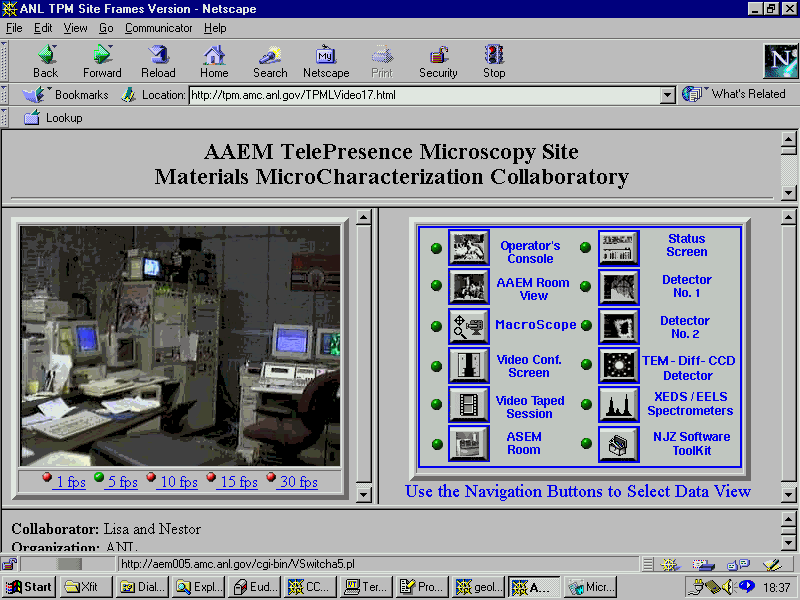

Internet Workshop for AXAA99
Lachlan M. D. Cranswick]
CCP14 for Single Crystal and Powder Diffraction
CLRC, Daresbury Laboratory X-ray Synchrotron
Daresbury, Warrington, Cheshire, WA4 4AD, UK
E-mail: L.Cranswick@dl.ac.uk
Web: http://www.ccp14.ac.uk
Overall Aim:
Hopefully give an idea of the internet as a powerful resource that when used properly can also be time and money saving over non-internet communications technology.
Give you a list of decent (and hopefully stable) starting links to obtain information and resources relevant to applying the internet for your X-ray and related work.
(By default, the internet can be a major time wasting engine so it can be a good idea to work out which uses are beneficial and the amount of resources (time, money) you wish to spend)
Only a brief subset of internet software is mentioned here as there is a major and growing software glut which makes it very difficult to keep up to date. (Stick with the software you trust)
Search Engines
Before Starting, it is good to note information about Internet Search Engines to find/refind information:
Inference Find (searches other search engines):
http://www.infind.com
Altavista
http://www.altavista.com/
http://www.altavista.yellowpages.com.au/
Hotbot
http://www.hotbot.com
Lycos
http://www.lycos.com
Yahoo
http://www.yahoo.com
The Internet - background - usual guff
Originally a military network that would in theory remain operable before, during and after a nuclear war.
http://www.arpa.mil/
Not so long ago, a connection of Academic Networks
http://www.aarnet.edu.au
http://www.internet2.edu/
http://www.ukerna.ac.uk/
Now; quite an amount of Hype but also becoming quite indispensable in many areas where cheap communication irrespective of many geographical boundaries is a plus.
Internet Society:
http://www.isoc.org/internet-history/
http://info.isoc.org/guest/zakon/Internet/History/HIT.html
Connecting to the Internet
Connecting to the internet has become so trivial that it does not need to be discussed in any depth but be wary of buggy software drivers for network cards, modems and network protocols.
If having difficulty, make sure you have the latest drivers. Unfortunately, obtaining the latest drivers is normally done via the internet. Thus you may have to use a colleague's internet connection to do this.
Network support should setup most laboratory PCs (or provide instructions). Most decent commercial ISPs now have a Wizard setup or generic setup that is friendly to most major operating systems.
E-mail (Electronic Mail)
Sending and Receiving text, messages, data and binaries
Some Software:
Eudora (Eudora Lite /Eudora Pro):
http://www.eudora.com
Pegasus E-mail (freeware):
http://www.pegasus.usa.com/
http://www.let.rug.nl/pegasus/
Pine for UNIX, DOS and Window
http://www.washington.edu/pine/
Elm for UNIX
comp.mail.elm
Netscape
http://www.netscape.com/
MicroSoft Based
MS-Mail, MS-Exchange, Internet Explorer(?)
(MS-Software is quite a nightmare)
http://www.microsoft.com/
Others. Refer the online software archives, indexes:
http://www.winfiles.com/
http://garbo.uwasa.fi/
http://www.tucows.com
http://wuarchive.wustl.edu/
http://www.simtel.net/simtel.net/
E-mail: Attaching Binary Files
Generally the most frustrating part of E-mail due to three differing methods of encoding files (some mail systems are quite limited to the size of files you can send via E-mail 50kB to 2Meg):
MIME,
UUENCODE
BINHEX
Advice, if possible, use an E-mail program that can handle all the main formats. Eudora is a personal favourite though any decent E-mail program should be able to attach and extract binary files in an easy and efficient manner:


In the following case, double clicking on the attached file line with the mouse will open the file with an appropriate program:

Different software allows different methods of manipulating attachments.
Newsgroups
Is a very large bulletin-board system on the internet.
Very useful for solving computer problems (large amount of computer based newsgroups) and also useable for scientific discussion.
sci.techniques.xtallography
http://www.unige.ch/crystal/stxnews/stx/welcome.htm
sci.techniques.spectroscopy
http://lolita.colorado.edu/faq/DEFAULT.HTM
sci.techniques.microscopy
sci.techniques.testing.nondestructive
sci.engr.metallurgy
sci.engr.mining
sci.geo.mineralogy
sci.geo.geology
sci.chem.analytical
sci.materials.ceramics
Scientific newsgroups tend not to be overly used, but they can have their good moments:
Background links at:
http://www.bio.net/BIOSCI/docs.html
Your Network Support or ISP should be able to provide information on the news-server "address" you should use.
Some News Reading Software
Forte Agent
Free Agent (freeware), Agent (commercial)
Also can be used as an off-line newsreader
http://www.forteinc.com/agent/
Trumpet Newsreader
http://www.trumpet.com.au
Netscape communicator has a newsreader
http://www.netscape.com
Pine for UNIX, DOS, Window has a Newsreader
http://www.washington.edu/pine/
Tin for UNIX
http://www.tin.org/
Simple News Example
(Note, this is a highly specialist question)
On the 3rd of December, 1998, Bath, UK
Martin McLoughlin Queries:
Newsgroups: sci.techniques.xtallography
Subject: PBC analysis software
Sender: mspmjm@bath.ac.uk (Verified by Kerberos)
Organization: School of Material Science, University of Bath, UK
Date: Thu, 3 Dec 1998 15:29:49 GMT
Hi,
Does anyone know of any public domain/shareware software for finding
periodic bond chains in crystal structures.
Thanks in advance
Martin McLoughlin
Dept. of Materials Science
On the 6th of December, 1998, Bulgarian Acad. Sci.
Thomas Kerestedjian Replies:
From: Thomy@my-dejanews.com
Newsgroups: sci.techniques.xtallography
Subject: Re: PBC analysis software
Date: Sun, 06 Dec 1998 09:32:32 GMT
Hi Martin,
To the best of my knowledge, there is only one piece of software for this
purpose. You can contact the author: Dr. Christina Strom; c.strom@elsevier.nl
This is a very proffesional tool for finding literaly ALL possible PBCs. The
only bad news is that it is not user friendly at all and you definitely need
authors assistance to get introduced to its operation.
Good luck,
--
Dr. Thomas Kerestedjian,
Geol. Inst., Bulgarian Acad. Sci.‰
-------== Posted via Deja News, The Discussion Network ==----------
On the 7th of December, 1998, Bradford, UK
John Osborn Follows On:
From: John Osborn <j.c.osborn@br.ac.uk>
Newsgroups: sci.techniques.xtallography
Subject: Re: PBC analysis software
Date: Mon, 07 Dec 1998 10:40:11 +0000
Organization: University of Bradford
A more user-friendly version of the Hartman-Perdok morphology
calculation with periodic bond chain analysis is implemented in the
latest version of the Cerius2 molecular modelling package (Molecular
Simulations Inc.). However this package is commercial, not public
domain as requested by the original poster.
--
John Osborn
University of Bradford, UK.
Mailing Lists
These are discussion groups/bulletin boards that are distributed via E-mail. Like newsgroups, there are a large variety of mailing lists (especially for computer software):
Rietveld Users Mailing List:
http://www.unige.ch/crystal/stxnews/riet/welcome.htm
CCP14 Software Hints Mailing List:
http://www.ccp14.ac.uk/maillist/
Clay Minerals Mailing
http://shadow.agry.purdue.edu/clay/claymin/listserv.html
Very-low-grade metamorphism mailing list
http://www.geol.uni-erlangen.de/vlgm/mail/mailing.html
Telnetting to Other Computers
(Possibly relevant for "collaboratories")
Normally done to UNIX, VAX or Mainframe computers.
You log in to the remote computer and can use any of the programs on the remote computer remotely. This can be databases, number crunching software, scientific equipment, etc.
If you are doing this, basic telnet is unencrypted and information including passwords is passed over the network in plain text. A common way around this is to use Secure Shell (SSH). The requires the installation of a "sshd" daemon on the remote computer which the system manager normally does.
There are many client programs for non-UNIX systems (client "slogin" programs.
Free - Teraterm and TTSSH for Teraterm for Win95/NT
http://hp.vector.co.jp/authors/VA002416/teraterm.html
http://www.zip.com.au/~roca/ttssh.html
As mentioned later, Security over the internet has become a major issue and also money spinner is selling security software and solutions. This is also relevant when using "remote" systems over the internet or "collaboratories".
FTP
Stands for File Transfer Protocol
Overshadowed by the World Wide Web but still a used protocol for transferring files.
Has advantages over attaching files to E-mail in that much larger amounts of data can be transferred (Megs to Gigs).
"Anonymous FTP" is support by any decent Web Browser such as Netscape, Internet Explorer, Opera, etc.
Windows and UNIX provides a command line FTP program (in a shell prompt, type ftp).
Point and Click GUI Freeware/shareware/commercial FTP programs are available. An example is WS_FTP:
http://www.ipswitch.com
NS: After "getting" a file via FTP, you find out it is corrupted, try "getting" the file in binary mode.
World Wide Web
Presently the common method of presenting information on the internet for either general or "restricted" access:
"Soft" Scientific and General Information, tutorials, corporate information
"Hard" Scientific Information: electronic versions of journals.
It is also becoming a common method to control equipment via the internet:
Collaboratories
Configuring computers and equipment
Common Software:
Netscape http://www.netscape.com/
Internet Explorer http://www.microsoft.com/ie/
Opera http://www.operasoftware.com/
Lynx http://www.fdisk.com/doslynx/lynxport.htm
(many other web browsers are available)
IRC (Internet Relay Chat) Keyboard based real time meetings Commonly used for children meeting over the internet (and also hackers). Only use this myself for Australasian Web Publishers Association committee meetings (http://www.awpa.asn.au) - no longer even that as Daresbury Lab blocks IRC from the network as an anti-hacker measure. Software: mIRC http://www.mirc.com/ ICQ http://www.icq.com/ Other software - check out via various software archives: Coast to Coast Windows Software Archive http://www.coast.net/ Tucows: http://www.tucows.com/ Wuarchive: http://wuarchive.wustl.edu/ simtel.net: http://www.simtel.net/simtel.net/ Garbo: http://garbo.uwasa.fi/ WinFiles.com: http://www.winfiles.com/ 32bit.com: http://www.32bit.com/ download.com: http://www.download.com/
Voice/Video Telephony Using the Internet Despite requests, personally don't use this as prefer to use a conventional phone. Mainly (given E-mail takes enough of the day) adding IRC and ICQ type facilities has the potential to further erode "productive time" especially when people enjoy using this just to check out the technology. There are a number of competing programs; normally supplied with hardware that enables this for video conferencing. e.g: Freetel: http://www.freetel.inter.net/ Iphone: http://www.vocaltec.com/ TeleVox/Cyberphone: http://www.voxware.com
Computer/Anti-Hacker Security (protect your data; confidential information; stop hackers and other illegal entry into your network and computer) Implement at the "required" level consistent with your setup and computer systems. Is really a network support/ISP issue. But if they are under-resourced, you may end up having to implement this yourself. Decent passwords can help. Latest security patches for your operating system. Avoiding dodgy areas of the internet - pirate software, pornography (many software viruses and Trojan horses are attached to pirate software or viewers available from pornography sites) Firewalls Help limit people's ability to hack into your network. Can also stop collaborative work if not set up appropriately Various types of security software and links to information relevant to the above: http://www.ccp14.ac.uk/ccp14admin/security/ NB: It is normally safe to assume private E-mail messages may eventually reach the pubic domain. Especially if sent on a mailing list.
X-ray Applications Finding Software/Software Upgrades Transfer of Data and Results Convenient information about the latest hardware. Assistance in Solving Technical Problems Databases On-line ICSD Inorganic Structure Database Demo: http://icsd.ccp14.ac.uk/icsd/ American Mineralogist Crystal Structure Database http://www.geo.arizona.edu/xtal-cgi/test http://www.geo.arizona.edu/xtal/personal.html Remote Control of Equipment Barns at ILL: http://barns.ill.fr Web Controllable Diffractometer: Computers & Geoscience Vol 24, No 7, pp 633-640, 1998 http://www.geosci.ipfw.indiana.edu/ Source Code Available via: http://www.iamg.org/CGEditor/index.htm
XRD Starting Links Rather than bombard with a large range of links (that may or may not die in the near future) following are starting links into XRD, X-ray related resources Australian X-ray Analytical Association http://www.latrobe.edu.au/www/axaa/ Society of Crystallographers In Australia http://www.sca.asn.au International Union of Crystallographers http://www.iucr.org/iucr-top/ IUCr - Crystallography World Wide: (database of software links) http://www.iucr.org/sincris-top// IUCr - Crystallography World Wide: (links to vendors, resources, educational material, databases, jobs, news) http://www.iucr.org/cww-top/ http://www.us.iucr.org/cww-top/ (USA) http://www.za.iucr.org/cww-top/ (South Africa) http://www.se.iucr.org/cww-top/ (Sweden) http://www.il.iucr.org/cww-top/ (Israel) http://www.ch.iucr.org/cww-top/ (Switzerland) CCP14 - Collaborative Computation Project for Single Crystal and Powder Diffraction (archive of software/web resources, Q&A, tutorials, developer resources) http://www.ccp14.ac.uk International Centre for Diffraction Data http://www.icdd.com
TelePresence - Collaboratories Interacting with Machine Operator Remotely as though you were there in the lab. Using/controlling equipment via the internet Telemicroscopy SEMs/Microprobes References - http://www.minerals.csiro.au/em-unit/microres.htm Though in practise, the most successful applications are those where the user interacts remotely with the actual machine operator. Can be started with relatively cheap off the shelf equipment such as the Logitech "QuickCam" (http://www.quickcam.com/) The National Center for Microscopy and Imaging Research (NCMIR) http://www-ncmir.ucsd.edu/ ANL Microscopy and Microanalysis WWW Server - http://www.amc.anl.gov http://tpm.amc.anl.gov Options for Authorised Users Controlling the Position of a Camera in the USA at CSIRO Australia Telepresence Microscopy at the University of Queensland Centre for Microcopy and Microanalysis, Brisbane, Australia at http://www.uq.edu.au/nanoworld/nanohome.html Based around the CU-SeeMe software (http://www.cu-seeme.com)
Conclusion The internet can be a major asset when used appropriately. However, don't end up wasting too much time!


